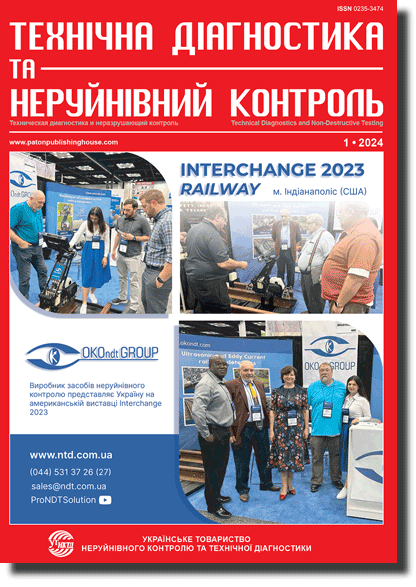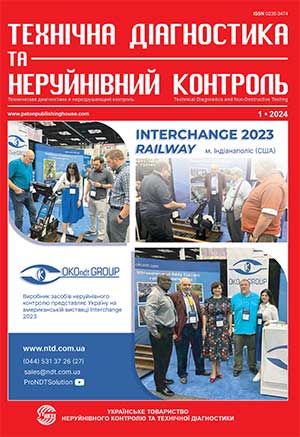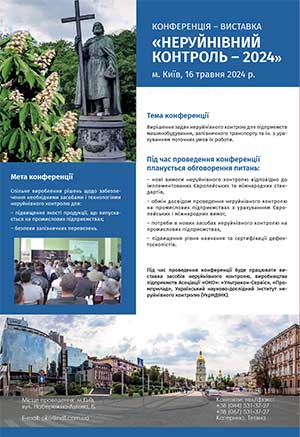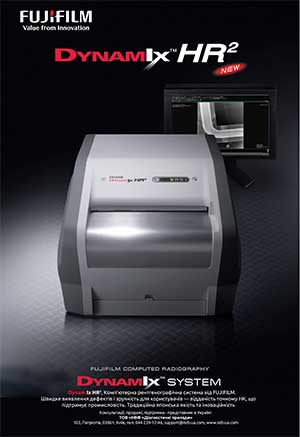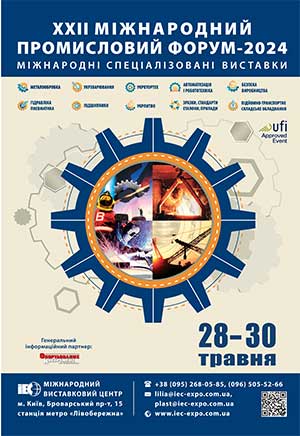| 2024 №01 (02) |
DOI of Article 10.37434/tdnk2024.01.03 |
2024 №01 (04) |
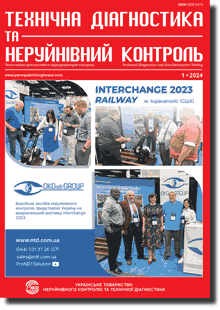
"Tekhnichna Diahnostyka ta Neruinivnyi Kontrol" (Technical Diagnostics and Non-Destructive Testing) #1, 2024, pp. 14-20
Investigations of the causes for damage in a plate heat exchanger from stainless steel AISI 316L in a food industry enterprise
L.I. Nyrkova, S.O. Osadchuk, L.V. Honcharenko, V.A. Kostin
E.O. Paton Electric Welding Institute of the NAS of Ukraine 11 Kazymyr Malevych Str., 03150, Kyiv, Ukraine. E-mail: office@paton.kiev.uaA complex of studies has been performed to establish the causes for damage of a platelike heat exchanger from AISI 316L stainless steel. Analysis of service conditions, methods of optical, scanning microscopy, visual examination, massometry, physical methods of media analysis, and testing for local corrosion resistance were used to establish the causes for formation of through-thickness damage of heat exchanger plates. It was proved that initiation of through-thickness defects is due to complex interaction of a set of factors, namely: breaking up of passive film in the points of plate abutment, development of intercrystalline corrosion of the surface layer at long downtime of a heat exchanger with a disinfectant preservative liquid, leading to formation of stagnant zones between the corrugations of the plates pressed to one another, where the liquid was retained, and increase of water corrosiveness relative to steel. 22 Ref., 4 Tabl., 5 Fig.
Keywords: stainless steel, heat exchanger, pitting corrosion, local corrosion resistance, corrosion rate
Received: 22.02.2024
Received in revised form: 11.03.2024
Accepted: 22.03.2024
References
1. Faes, W., Lecompte, S., Ahmed, Z.Y. et al. (2019) Corrosion and corrosion prevention in heat exchangers. Corrosion reviews, 37(2), 131-155. https://doi.org/10.1515/corrrev-2018-00542. Fan, Z.D., Du, J.S., Zhang, Z.B. et al. (2019) Internal leakage of plate heat exchangers caused by cooperation of pitting, crevice corrosion, and fretting. Engineering Failure Analysis, 96, 340-347. https://doi.org/10.1016/j.engfailanal.2018.10.007
3. Deen, K.M., Virk, M.A., Haque, C.I. et al. (2010) Failure investigation of heat exchanger plates due to pitting corrosion. Engineering Failure Analysis, 17(4), 886-893. https://doi.org/10.1016/j.engfailanal.2009.10.023
4. Khodamorad, S.H., Alinezhad, N., Fatmehsari, D.H., Ghahtan, K. (2016) Stress corrosion cracking in type. 316 plates of a heat exchanger. Case Studies in Engineering Failure Analysis, 5, 59-66. https://doi.org/10.1016/j.csefa.2016.03.001
5. Song, M.J., Choi, G., Chae, H. et al. (2021) Corrosion failure analysis of flow plate in plate heat exchanger. Corrosion Science and Technology, 20(4), 204-209. DOI: https://doi.org/10.14773/cst.2021.20.4.204
6. Song, W.M., Yang, G.R., Hao, Y., Zhang, Y.F. (2013) The corrosion failure analysis of plate pipe for plate heat exchanger. Advanced materials research, 750, 2252-2257. https://doi.org/10.4028/www.scientific.net/AMR.750-752.2252
7. Ali, M., Ul-Hamid, A., Khan, T. et al. (2021) Corrosion-related failures in heat exchangers. Corrosion Reviews, 39(6), 519-546. https://doi.org/10.1515/corrrev-2020-0073
8. Narivs' kyi, O.E. (2007) Micromechanism of corrosion fracture of the plates of heat exchangers. Materials Science, 43(1), 124-132. https://doi.org/10.1007/s11003-007-0014-3
9. Wassilkowska, A., Skowronek, T., Rybicki, S. (2022) Microstructure investigation of premature corroded heat exchanger plates. Materials Testing, 58(3), 218-223. https://doi.org/10.3139/120.110837
10. Solomon, N., Solomon, I. (2017) Effect of deformation-induced phase transformation on AISI 316 stainless steel corrosion resistance. Engineering Failure Analysis, 79, 865- 875. https://doi.org/10.1016/j.engfailanal.2017.05.031
11. Li, M.J., Tang, S.Z., Wang, F.L. et al. (2017) Gas-side fouling, erosion and corrosion of heat exchangers for middle/low temperature waste heat utilization: A review on simulation and experiment. Applied Thermal Engineering, 126, 737-761. https://doi.org/10.1016/j.applthermaleng.2017.07.095
12. Jong-Soon, K.I.M., Tae-Ho, K.A.N.G., In-Kwan, K.I.M. (2009) Surface treatment to improve corrosion resistance of Al plate heat exchangers. Transactions of Nonferrous Metals Society of China, 19, 28-31. https://doi.org/10.1016/S1003-6326(10)60240-3
13. Davíðsdóttir, S., Gunnarsson, B.G., Kristjánsson, K.B. et al. (2021) Study of corrosion resistance properties of heat exchanger metals in two different geothermal environments. Geosciences, 11(12), 498. https://doi.org/10.3390/geosciences11120498
14. Reppich, M. (1999) Use of high performance plate heat exchangers in chemical and process industries. International j. of thermal sciences, 38(11), 999-1008. https://doi.org/10.1016/S1290-0729(99)00109-X
15. Turissini, R.L., Bruno, T.V., Dahlberg, E.P., Setterlund, R.B. (1997) March. Corrosion failures in plate heat exchangers. In: NACE CORROSION (pp. NACE-97522), NACE.
16. ASTM A 240/A 240M - 04 Specification for heat-resisting chromium and chromium-nickel stainless steel plate, sheet, and strip for pressure vessels.
17. ASTM G48-11(2020)e1 Standard test methods for pitting and crevice corrosion resistance of stainless steels and related alloys by use of ferric chloride solution.
18. GOST 2999-75 (ST SEV 470-77) Metals and alloys. Vickers hardness measurement method. With changes № 1, 2 [in Russian].
19. BS EN 12502-4:2004 Protection of metallic materials against corrosion - Guidance on the assessment of corrosion likelihood in water distribution and storage systems ?? Part 4: Influencing factors for stainless.
20. Shreir, L.L. (2010) 1.05-Basic concepts of corrosion. Shreir's corrosion. Oxford, Elsevier, pp. 89-100. ISBN 978-0-444-52788-2. https://doi.org/10.1016/B978-044452787-5.00006-8
21. DSTU EN ISO 3651-2:2005. The steel is corroded. Increased toughness to intercrystalline corrosion. Part 2. Feritic, austenitic and ferritic-austenitic (dual-phase) steels. Testing for corrosion in sulfuric acid media (EN ISO 3651-2:1998, IDT) [in Ukrainian].
22. Cleland, J.H. (1996) What does the pitting resistance equivalent really tell us? Engineering Failure Analysis, 3(1), 65-69. https://doi.org/10.1016/1350-6307(95)00026-7
Advertising in this issue:
The cost of subscription/purchase order journals or individual articles
| Journal/Currency | Annual Set | 1 issue printed |
1 issue |
one article |
| TPWJ/USD | 384 $ | 32 $ | 26 $ | 13 $ |
| TPWJ/EUR | 348 € | 29 € | 24 € | 12 € |
| TPWJ/UAH | 7200 UAH | 600 UAH | 600 UAH | 280 UAH |
| AS/UAH | 1800 UAH | 300 UAH | 300 UAH | 150 UAH |
| AS/USD | 192 $ | 32 $ | 26 $ | 13 $ |
| AS/EUR | 180 € | 30 € | 25 € | 12 € |
| SEM/UAH | 1200 UAH | 300 UAH | 300 UAH | 150 UAH |
| SEM/USD | 128 $ | 32 $ | 26 $ | 13 $ |
| SEM/EUR | 120 € | 30 € | 25 € | 12 € |
| TDNK/UAH | 1200 UAH | 300 UAH | 300 UAH | 150 UAH |
| TDNK/USD | 128 $ | 32 $ | 26 $ | 13 $ |
| TDNK/EUR | 120 € | 30 € | 25 € | 15 € |
AS = «Automatic Welding» - 6 issues per year;
TPWJ = «PATON WELDING JOURNAL» - 12 issues per year;
SEM = «Electrometallurgy Today» - 4 issues per year;
TDNK = «Technical Diagnostics and Non-Destructive Testing» - 4 issues per year.





